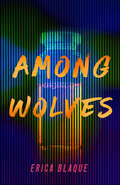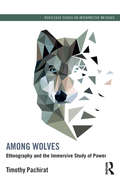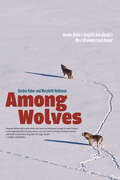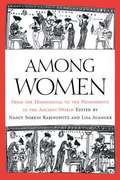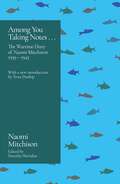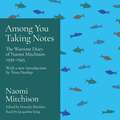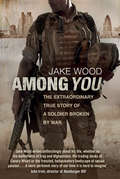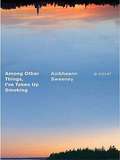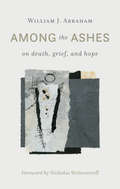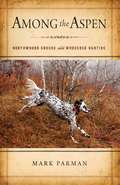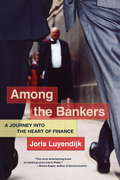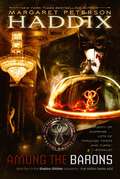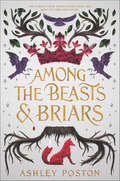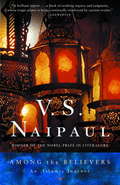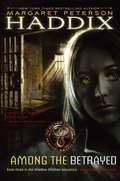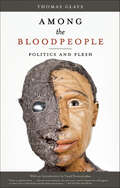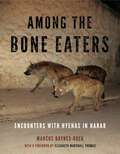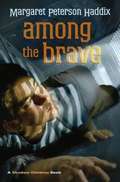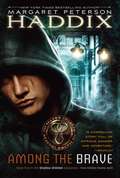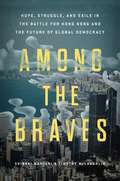- Table View
- List View
Among Wolves
by Erica BlaqueWhen a CEO is accused of murder, his wife investigates his dark secret life in this thriller &“full of surprises . . . sure to satisfy fans of Liane Moriarty and Louise Candlish&” (Booklist). My husband is a self-important asshole, but he isn&’t a murderer . . . At least that&’s what Sophia Claire believes when faced with a visit from two detectives. She&’s been enjoying what appears to be a storybook life in Deep River, Washington, with her husband, Robert, the wealthy, intelligent, and attractive CEO of massive pharmaceutical research company ANEXA. That is, until the detectives inform Sophia that they&’re investigating a string of murders of young women who have at least one thing in common: They were all Rob&’s lovers. In the face of these accusations, Sophia is forced to question the realities of her marriage, which is moving toward the brink of collapse. What is the nature of their love for each other? When does love die, exactly? She still believes Rob loves her—he loves her body, her grace, and her ability to fit the lifestyle of a prominent CEO. But she also knows he&’s cheated. As the detectives work toward an arrest, Sophia begins to doubt her own commitments, the motivations of those around her, and her sanity. Reaching her breaking point, she hunts for answers about her husband&’s affairs—and instead finds herself drawn to the sexual extremes of his secret life . . . A twisty, sexy, and surprising debut, Among Wolves will have you riveted until the last page is turned.
Among Wolves: Ethnography and the Immersive Study of Power (Routledge Series on Interpretive Methods)
by Timothy PachiratSummoned by an anonymous Prosecutor, ten contemporary ethnographers gather in an aging barn to hold a trial of Alice Goffman’s controversial ethnography, On the Run. But before the trial can get underway, a one-eyed wolfdog arrives with a mysterious liquid potion capable of rendering the ethnographers invisible in their fieldsites. Presented as a play that unfolds in seven acts, the ensuing drama provides readers with both a practical guide for how to conduct immersive participant-observation research and a sophisticated theoretical engagement with the relationship between ethnography as a research method and the operation of power. By interpolating "how-to" aspects of ethnographic research with deeper questions about ethnography’s relationship to power, this book presents a compelling introduction for those new to ethnography and rich theoretical insights for more seasoned ethnographic practitioners from across the social sciences. Just as ethnography as a research method depends crucially on serendipity, surprise, and an openness to ambiguity, the book’s dramatic and dialogic format encourages novices and experts alike to approach the study of power in ways that resist linear programs and dogmatic prescriptions. The result is a playful yet provocative invitation to rekindle those foundational senses of wonder and generative uncertainty that are all too often excluded from conversations about the methodologies and methods we bring to the study of the social world.
Among Wolves: Gordon Haber's Insights into Alaska's Most Misunderstood Animal
by Marybeth Holleman Gordon HaberAlaska’s wolves lost their fiercest advocate, Gordon Haber, when his research plane crashed in Denali National Park in 2009. Passionate, tenacious, and occasionally brash, Haber, a former hockey player and park ranger, devoted his life to Denali’s wolves. He weathered brutal temperatures in the wild to document the wolves and provided exceptional insights into wolf behavior. Haber’s writings and photographs reveal an astonishing degree of cooperation between wolf family members as they hunt, raise pups, and play, social behaviors and traditions previously unknown. With the wolves at risk of being destroyed by hunting and trapping, his studies advocated for a balanced approach to wolf management. His fieldwork registered as one of the longest studies in wildlife science and had a lasting impact on wolf policies. Haber’s field notes, his extensive journals, and stories from friends all come together in Among Wolves to reveal much about both the wolves he studied and the researcher himself. Wolves continue to fascinate and polarize people, and Haber’s work continues to resonate.
Among Women across Worlds: North Korea in the Global Cold War
by Suzy KimIn Among Women across Worlds, Suzy Kim explores the transnational connections between North Korean women and the global women's movement. Asian women, especially communists, are often depicted as victims of a patriarchal state. Kim challenges this view through extensive archival research, revealing that North Korean women asserted themselves from the late 1940s to 1975, before the Korean War began and up to the UN's International Women's Year.Kim centers on North Korea and the "East" to present a new genealogy of the global women's movement. Women of the Korean Democratic Women's Union (KDWU), part of the global left women's movement led by the Women's International Democratic Federation (WIDF), argued that family and domestic issues should be central to both national and international debates. They highlighted the connections between race, nationality, sex, and class in systems of exploitation. Their intersectional program proclaimed "no peace without justice," "the personal is the political," and "women's rights are human rights," long before Western activists adopted these ideas. Among Women across Worlds uncovers movements and ideas foundational to today's era.
Among Women: From the Homosocial to the Homoerotic in the Ancient World
by Lisa Auanger Nancy Sorkin RabinowitzWomen's and men's worlds were largely separate in ancient Mediterranean societies, and, in consequence, many women's deepest personal relationships were with other women. Yet relatively little scholarly or popular attention has focused on women's relationships in antiquity, in contrast to recent interest in the relationships between men in ancient Greece and Rome. The essays in this book seek to close this gap by exploring a wide variety of textual and archaeological evidence for women's homosocial and homoerotic relationships from prehistoric Greece to fifth-century CE Egypt.<P> Drawing on developments in feminist theory, gay and lesbian studies, and queer theory, as well as traditional textual and art historical methods, the contributors to this volume examine representations of women's lives with other women, their friendships, and sexual subjectivity. They present new interpretations of the evidence offered by the literary works of Sappho, Ovid, and Lucian; Bronze Age frescoes and Greek vase painting, funerary reliefs, and other artistic representations; and Egyptian legal documents.
Among You Taking Notes...
by Naomi Mitchison'As in a good novel, the people, their feelings and reactions are instantly recognisable and as fresh and immediate today as they were then' GUARDIAN'She writes vividly and movingly' DAILY TELEGRAPH26th September 1939. I am beginning to wonder whether the point of a place like this may be that it will keep alive certain ideas of freedom which might easily be destroyed in the course of this totalitarian war...Born in Edinburgh, Naomi Mitchison spent most of the Second World War in the fishing village of Carradale on Kintyre, her home until her death aged 101. Her life was crowded with incident, and her attitudes to events predictably forceful, original and honest.Throughout the war she kept a diary at the request of the research organisation Mass Observation, in which she recorded both the momentous events of the time, and also how one (albeit extraordinary) family and their friends lived, what they hoped for and what actually happened. Her diaries developed far beyond the confines of a social document.Written with the passion of a poet combined with the intellectual curiosity of a radial thinker, they provide a unique and valuable document of the period.
Among You Taking Notes...
by Naomi Mitchison'As in a good novel, the people, their feelings and reactions are instantly recognisable and as fresh and immediate today as they were then' GUARDIAN'She writes vividly and movingly' DAILY TELEGRAPH26th September 1939. I am beginning to wonder whether the point of a place like this may be that it will keep alive certain ideas of freedom which might easily be destroyed in the course of this totalitarian war...Born in Edinburgh, Naomi Mitchison spent most of the Second World War in the fishing village of Carradale on Kintyre, her home until her death aged 101. Her life was crowded with incident, and her attitudes to events predictably forceful, original and honest.Throughout the war she kept a diary at the request of the research organisation Mass Observation, in which she recorded both the momentous events of the time, and also how one (albeit extraordinary) family and their friends lived, what they hoped for and what actually happened. Her diaries developed far beyond the confines of a social document.Written with the passion of a poet combined with the intellectual curiosity of a radial thinker, they provide a unique and valuable document of the period.
Among You Taking Notes…
by Naomi Mitchison26th September 1939. I am beginning to wonder whether the point of a place like this may be that it will keep alive certain ideas of freedom which might easily be destroyed in the course of this totalitarian war…. <p><p>Born in Edinburgh, Naomi Mitchison spent most of the Second World War in the fishing village of Carradale on Kintyre, her home until her death aged 101. Her life was crowded with incident, and her attitudes to events predictably forceful, original and honest. <p><p>Throughout the war she kept a diary at the request of the research organisation Mass Observation, in which she recorded both the momentous events of the time, and also how one (albeit extraordinary) family and their friends lived, what they hoped for and what actually happened. Her diaries developed far beyond the confines of a social document. <p><p>Written with the passion of a poet combined with the intellectual curiosity of a radial thinker, they provide a unique and valuable document of the period.
Among You: The Extraordinary True Story of a Soldier Broken by War
by Jake WoodAmong You is the gripping real-life story of a soldier serving on the front line in Iraq and Afghanistan, and an unforgettable, unflinching account of the effects of post-traumatic stress disorder.Jake Wood lives parallel lives: encased in the glass tower of an international investment bank by day, he is also a dedicated TA soldier who serves on the front line during the invasion of Iraq, later returning to the war zone to conduct surveillance on insurgents. Disillusioned with the dullness and amorality of the banking world, he escapes back to the army for a third tour of duty. But in Afghanistan he discovers the savage, dehumanising effects that war has on both the body and the mind. Diagnosed with chronic PTSD on his return, he must now fight the last enemy – himself – in order to exorcise the ghosts of his past.Brutally honest and beautifully written, Among You brings home the harsh reality of front-line combat in Iraq and Afghanistan, and the courage of the troops who risk their lives for their country, as well as revealing the devastating after-effects of service.
Among other things, I've taken up smoking
by Aoibheann SweeneyCritically acclaimed by reviewers across the country, Aoibheann Sweeney?s beautifully written debut novel is a story of the profound human need for intimacy. For Miranda, the adolescence spent in her fog-shrouded Maine home has been stark and isolated? alone with her troubled father, a man consumed with his work translating Ovid?s Metamorphoses, her mother mysteriously gone from their lives. Now, having graduated from high school, Miranda?s father arranges for her to stay with old friends in Manhattan, and she embarks on a journey that will open up her father?s past?and her own world?in ways she cannot begin to imagine. .
Among the Ashes: On Death, Grief, and Hope
by William J. AbrahamHow can we hold fast to the hope of life eternal when we lose someone we love? In this book William Abraham reflects on the nature of certainty and the logic of hope in the context of an experience of devastating grief. Abraham opens with a stark account of the effects of grief in his own life after the unexpected death of his oldest son. Drawing on the book of Job, Abraham then looks at the significance of grief in debates about the problem of evil. He probes what Christianity teaches about life after death and ultimately relates our experiences of grief to the death of Christ. Profound and beautiful, Among the Ashes tackles the philosophical and theological questions surrounding loss even as it honors the experience of grief.
Among the Ashes: On Death, Grief, and Hope
by William J. AbrahamHow can we hold fast to the hope of life eternal when we lose someone we love? In this book William Abraham reflects on the nature of certainty and the logic of hope in the context of an experience of devastating grief. Abraham opens with a stark account of the effects of grief in his own life after the unexpected death of his oldest son. Drawing on the book of Job, Abraham then looks at the significance of grief in debates about the problem of evil. He probes what Christianity teaches about life after death and ultimately relates our experiences of grief to the death of Christ. Profound and beautiful, Among the Ashes tackles the philosophical and theological questions surrounding loss even as it honors the experience of grief.
Among the Aspen: Northwoods Grouse and Woodcock Hunting
by Mark ParmanFollowing his English setters into thickets in search of grouse and woodcock, Mark Parman feels the pull of older ways and lost wisdom. How rare it is, in our high-tech world, to find oneself completely off the track, bewildered in the wild, and then find the path home by sight and scent and memory. Among the Aspen interweaves tales of companionable dogs, lucky hunts, and favorite coverts where quarry lurks with ruminations on the demise of hunting traditions, the sale of public lands and the privatization of places to hunt, the growing indifference to science, and the loss of wilderness on a planet increasingly transformed by the sprawl of humanity.
Among the Bankers: A Journey into the Heart of Finance
by Joris LuyendijkJoris Luyendijk, an investigative journalist, knew as much about banking as the average person: almost nothing. Bankers, he thought, were ruthless, competitive, bonus-obsessed sharks, irrelevant to his life. And then he was assigned to investigate the financial sector. Joris immersed himself in the City--London's equivalent of Wall Street--for several years, speaking to over 200 people--from the competitive investment bankers and elite hedge-fund managers to downtrodden back-office staff, reviled HR managers, and those made redundant in the regular 'culls'. Breaking the strictly imposed code of secrecy and silence, these insiders spoke on record about what they actually do all day, how they see the toxic environment in which they work, and how they think the uninitiated see them. They confessed to feeling overwhelmed by the intransparency of our financial systems. They admitted that when Lehman Brothers went down in 2008 they hoarded food, put their money in gold, and prepared to evacuate their children to the countryside. They agreed that nothing has changed since the crash. A strange thing happens when you spend time among the bankers . . . you start to sympathize with them. What if the bankers themselves aren't the real enemy? What if the truth about global finance is more sinister than that?
Among the Barons: Among The Hidden; Among The Impostors; Among The Betrayed; Among The Barons; Among The Brave; Among The Enemy; Among The Free (Shadow Children #4)
by Margaret Peterson HaddixIn this fourth installment of a series about a society that allows only two children per family, Luke Garner is finally adjusting to his new life at Hendricks School as Lee Grant. While the Grants belong to the highest class of society called the Barons, Luke avoids snobbish affectations and befriends his classmates, who are also illegal thirds. When the real Lee Grant's younger brother arrives at the school, along with his fierce body guard, Luke worries that Smits will expose him to the government. However, Smits has come to enlist Luke's help in discovering how his older brother really died, suspecting that he was murdered. The intrigue and danger grow more acute when both boys are called "home" and Luke discovers that the Grants have plans for him that could turn out to be fatal.
Among the Beasts & Briars
by Ashley PostonAshley Poston, acclaimed author of Heart of Iron, returns with a dark, lush fairy tale–inspired fantasy for fans of Sara Raasch and Susan Dennard.Cerys is safe in the Kingdom of Aloriya. Here there are no droughts, disease, or famine, and peace is everlasting. It has been this way for hundreds of years, since the first king made a bargain with the Lady who ruled the forest that borders the kingdom. But as Aloriya prospered, the woods grew dark, cursed, and forbidden.Cerys knows this all too well: When she was young, she barely escaped as the woods killed her friends and her mother. Now Cerys carries a small bit of the curse—the magic—in her blood, a reminder of the day she lost everything.As a new queen is crowned, however, things long hidden in the woods descend on the kingdom itself. Cerys is forced on the run, her only companions a small and irritating fox from the royal garden and the magic in her veins. It’s up to her to find the legendary Lady of the Wilds and beg for a way to save her home.But the road is darker and more dangerous than she knows, and as secrets from the past are uncovered amid the teeth and roots of the forest, it’s going to take everything she has just to survive.
Among the Beautiful Beasts: A Novel
by Lori McMullenSet in the early 1900s, Among the Beautiful Beasts is the untold story of the early life of Marjory Stoneman Douglas, known in her later years as a tireless activist for the Florida Everglades. After a childhood spent in New England estranged from her father and bewildered by her mother, who fades into madness, Marjory marries a swindler thirty years her senior. The marriage nearly destroys her, but Marjory finds the courage to move to Miami, where she is reunited with her father and begins a new life as a journalist in that bustling, booming frontier town. Buoyed by a growing sense of independence and an affair with a rival journalist, Marjory embraces a life lived at the intersection of the untamed Everglades and the rapacious urban development that threatens it. When the demands of a man once again begin to swallow Marjory’s own desires and dreams, she sees herself in the vulnerable, inimitable Everglades and is forced to decide whether to commit to a life of subjugation or leap into the wild unknown. Told in chapters that alternate between an urgent midnight chase through the wetlands and extensive narrative flashbacks, Among the Beautiful Beasts is at once suspenseful and deeply reflective.
Among the Believers: An Islamic Journey
by V. S. NaipaulThe Nobel Prize-winning author gives us – on the basis of his own intensive seventeen month journey across the Asian continent – an unprecedented revelation of the Islamic world. • &“A brilliant report…. A book of scathing inquiry and judgment, whose tragic power is being continually reinforced by current events&” (Newsweek).With all the narrative power and intellectual authority that have distinguished his earlier books and won him international acclaim (&“There can hardly be a writer alive who surpasses him&” – Irving Howe, The New York Times Book Review), Naipaul explores the life, the culture, the ferment inside the nations of Islam – in a book that combines the fascinations of the great works of travel literature with the insights of a uniquely sharp, original, and idiosyncratic political mind. He takes us into four countries in the throes of &“Islamization&” – countries that, in their ardor to build new societies based entirely on the fundamental laws of Islam, have violently rejected the &“materialism&” of the technologically advanced nations that have long supported them. He brings us close to the people of Islam – how they live and work, the role of faith in their lives, how they see their place in the modern world.
Among the Betrayed: Among The Hidden; Among The Impostors; Among The Betrayed; Among The Barons; Among The Brave; Among The Enemy; Among The Free (Shadow Children #3)
by Margaret Peterson HaddixIn the third installment of Haddix's series about a futuristic society in which families are forbidden to have more than two children, Nina, a secondary character in Among the Impostors, is falsely accused of treason and imprisoned by the Population Police. Her interrogator gives her an ultimatum: either she can get three other child prisoners, illegal third-borns like Nina, to reveal who harbored them and where they got their fake identification cards, or she will be executed. Nina sees a chance to escape the prison and, taking the prisoners with her, quickly discovers their street smarts. But when their food supply runs out, Nina seeks the boy she knew as Lee.
Among the Bloodpeople: Politics and Flesh
by Thomas GlaveConcerns with human rights, political oppression, sexuality, race, and Jamaican culture thematically connect these essays.“This is a collection that will leave you with chills; you will return to it not only for its sheer beauty, but also for its raw honesty, pain, and passion.” —Lambda Literary Report—With an introduction by Pulitzer Prize–winning poet Yusef Komunyakaa.Thomas Glave has been admired for his unique style and exploration of taboo, politically volatile topics. The award-winning author’s new collection, Among the Bloodpeople, contains all the power and daring of his earlier writing but ventures even further into the political, the personal, and the secret.Each essay in the volume reveals a passionate commitment to social justice and human truth. Whether confronting Jamaica’s prime minister on antigay bigotry, contemplating the risks and seductions of “outlawed” sex, exploring a world of octopuses and men performing somersaults in the Caribbean Sea, or challenging repressive tactics employed at the University of Cambridge, Glave expresses the observations of a global citizen with the voice of a poet.
Among the Bone Eaters: Encounters with Hyenas in Harar (Animalibus: Of Animals and Cultures #8)
by Elizabeth Marshall Thomas Marcus Baynes-RockBiologists studying large carnivores in wild places usually do so from a distance, using telemetry and noninvasive methods of data collection. So what happens when an anthropologist studies a clan of spotted hyenas, Africa’s second-largest carnivores, up close—and in a city of a hundred thousand inhabitants? In Among the Bone Eaters, Marcus Baynes-Rock takes us to the ancient city of Harar in Ethiopia, where the gey waraba (hyenas of the city) are welcome in the streets and appreciated by the locals for the protection they provide from harmful spirits and dangerous “mountain” hyenas. They’ve even become a local tourist attraction.At the start of his research in Harar, Baynes-Rock contended with difficult conditions, stone-throwing children, intransigent bureaucracy, and wary hyena subjects intent on avoiding people. After months of frustration, three young hyenas drew him into the hidden world of the Sofi clan. He discovered the elements of a hyena’s life, from the delectability of dead livestock and the nuisance of dogs to the unbounded thrill of hyena chase-play under the light of a full moon. Baynes-Rock’s personal relations with the hyenas from the Sofi clan expand the conceptual boundaries of human-animal relations. This is multispecies ethnography that reveals its messy, intersubjective, dangerously transformative potential.
Among the Brave (Shadow Children #5)
by Margaret Peterson HaddixIn the aftermath of a crisis that threatens the safety of all "shadow children" -- illegal third-borns in a society that allows only two children per family -- Trey's friends expect him to take charge -- a function he doesn't want or think he can do. Trey's new role leads him to travel with Luke Garner's brother, Mark, to Population Police headquarters. There he impersonates an officer to try to rescue Luke, who has been taken prisoner.The nonstop adventure puts all three boys in danger and risks exposing the underground movement to help all shadow children. In this, the fifth book in the "Shadow Children" series, Margaret Peterson Haddix returns to the futuristic setting and compelling characters she created in "Among the Hidden". With an adrenaline-fueled plot and surprising twists, Haddix has again crafted a story that is suspenseful until the last page.
Among the Brave: Among The Hidden; Among The Impostors; Among The Betrayed; Among The Barons; Among The Brave; Among The Enemy; Among The Free (Shadow Children #5)
by Margaret Peterson HaddixIn the aftermath of a crisis that threatens the safety of all shadow children -- illegal third-borns in a society that allows only two children per family -- Trey's friends expect him to take charge -- a function he doesn't want or think he can do.Trey's new role leads him to travel with Luke Garner's brother, Mark, to Population Police headquarters. There he impersonates an officer to try to rescue Luke, who has been taken prisoner. The nonstop adventure puts all three boys in danger and risks exposing the underground movement to help all shadow children.In this, the fifth book in the Shadow Children series, Margaret Peterson Haddix returns to the futuristic setting and compelling characters she created in Among the Hidden. With an adrenaline-fueled plot and surprising twists, Haddix has again crafted a story that is suspenseful until the last page.
Among the Braves: Hope, Struggle, and Exile in the Battle for Hong Kong and the Future of Global Democracy
by Shibani Mahtani Timothy McLaughlinThrough the eyes of two frontline journalists comes a gripping narrative history of the Hong Kong pro-democracy movement centered around a cast of four core activists, culminating in the 2019 mass protests and Beijing's brutal crackdown. Hong Kong was an experiment in governance. Handed back to China in 1997 after 156 years of British rule, it was meant to be a carve-out between hostile systems: a bridge between communism and capitalism, authoritarianism and liberal democracy. &“One country, two systems&” kept its media free, its courts independent and its protests boisterous, designed also to convince Taiwan of a peaceful solution to Beijing&’s desire for reunification. Yet this formulation excluded Hong Kong&’s own people, their future negotiated by political titans in faraway capitals. In 2019, an ill-conceived law spear-headed by a sycophantic leader pushed millions to take to the streets in one of the most enduring protest movements the world has ever seen. Xi Jinping responded with a draconian national security law that sought not only to end the demonstrations but quash the &“problem&” of Hong Kongers&’ identity and desire for freedom. Reverend Chu, who believed Hong Kong had to carry the spirit of students at Tiananmen Square, saw his silver-haired comrades who birthed the city&’s modern pro-democracy movement handcuffed and taken from their homes. Tommy, an art student radicalized into throwing Molotov cocktails, watched &“braves&” like him brutalized by police before his own arrest prompted him to flee. Finn epitomized the decentralized nature of the movement and its internet-fueled victories, but online anonymity couldn&’t stop his life from unravelling. Gwyneth could predict her eventual fate when she chose to give up her career as a journalist to stand for election as an opposition candidate, and did it anyway. In Among the Braves, Shibani Mahtani and Timothy McLaughlin tell the story of Hong Kong&’s past, and what the sacrifices of its people mean for global democracy&’s shaky foundation.
